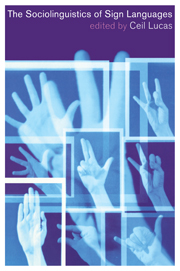Book contents
- Frontmatter
- Contents
- List of figures
- List of tables
- List of contributors
- Foreword
- Preface and acknowledgments
- List of abbreviations
- 1 Introduction
- 2 Multilingualism: The global approach to sign languages
- 3 Bilingualism and language contact
- 4 Sociolinguistic variation
- 5 Discourse analysis
- 6 Language planning and policy
- 7 Language attitudes
- Bibliography
- Index
2 - Multilingualism: The global approach to sign languages
Published online by Cambridge University Press: 24 November 2009
- Frontmatter
- Contents
- List of figures
- List of tables
- List of contributors
- Foreword
- Preface and acknowledgments
- List of abbreviations
- 1 Introduction
- 2 Multilingualism: The global approach to sign languages
- 3 Bilingualism and language contact
- 4 Sociolinguistic variation
- 5 Discourse analysis
- 6 Language planning and policy
- 7 Language attitudes
- Bibliography
- Index
Summary
A language is a dialect with an army and a navy.
AnonAnd the whole earth was of one language and of one speech.
Genesis 11:1Sign language is sometimes called gesture speech as it is a method of conversing by means of gestures or signs. It is a form of speech in use among civilised and savage races, which is perfectly understood, and although greatly limited in its forms of expression by those who have spoken language, rich in its vocabulary and possessed of an extensive literature.
John Maclean, 1896This chapter provides an overview of the occurrence and distribution of sign languages around the world. Every year, the existence of more sign languages and more signing communities is being recognized. Lexicography (the making of sign language dictionaries) and analyses of the structure and use of these languages follow recognition and play a key role in the empowerment of deaf people. This chapter provides an estimate of the number of sign languages in existence and describes the diversity of Deaf communities using sign languages. It outlines the different factors we need to consider when describing the existence of any language and shows why it is so difficult to provide an exact description of the distribution of sign languages.
- Type
- Chapter
- Information
- The Sociolinguistics of Sign Languages , pp. 8 - 32Publisher: Cambridge University PressPrint publication year: 2001
- 28
- Cited by

